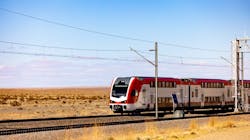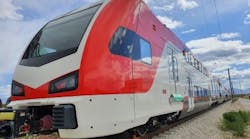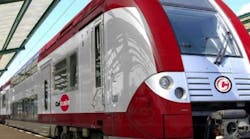Caltrain electrification: Project delayed until 2024; costs rise $333 million
Caltrain provided updated information about its electrification project on June 3 and the information wasn’t good news: the project is delayed and costs have increased.
Electrified service on Caltrain, a key component of the Caltrain Modernization Program, will not be a reality until late 2024 and it will take an additional $333 million to deliver the project. Service was originally slated to begin in the second quarter of 2022.
The Federal Transit Administration (FTA) is reviewing the delay and Caltrain says the lag is the result of several factors from complications in the installation of signal systems to unforeseen conditions under Caltrain’s tracks and severe disruptions to supply chains caused by the COVID-19 pandemic.
Caltrain Executive Director Michelle Bouchard recognizes the disappointment from the delay but says the rail service provider is fully committed to seeing the project delivered.
“These delays are disappointing, because the electrification of Caltrain is desperately needed,” said Bouchard. “However, much has already been accomplished, and together with our contractors, funding partners and stakeholders, we will deliver the modern rail service that the Bay Area deserves.”
Caltrain says progress to date on the construction of the project includes:
- 75 percent of foundations for the catenary poles are complete;
- 60 percent of the poles have been installed;
- All 10 of the traction power facilities are under construction;
- The overhead contact system has been installed in all of Caltrain’s four tunnels; and
- The first electric trainset has been completed and is currently being tested at the Transportation Technology Center in Pueblo, Colo.
The project will electrify a 51-mile corridor from San Francisco’s 4th and King Caltrain Station to the Tamien Caltrain Station and replace 75 percent of Caltrain’s diesel service with electric. The rolling stock components of the project included the design and purchase of 96 Electric Multiple Units, while the infrastructure side of the project included the installation of an Overhead Contact System and traction power substations. Once complete, the project will provide cleaner, greener and improved service to riders.
“There is no question that the electrification of Caltrain is vital to the Bay Area,” said Joint Powers Board (JPB) Chair Dev Davis. “It is the foundation of the expanded service that is necessary to shrink our carbon footprint, get cars off our highways and help people throughout the region get where they need to go conveniently and affordably.”
FTA prepared and shared with Caltrain a draft Risk Refresh Report based on the project’s progress. The report estimates the project will need an additional $333 million, increasing the project cost from $1.98 billion to $2.3 billion. Caltrain says it has identified a funding plan for the known and allocated costs of $161 million out of the forecasted $333 million. The remaining $172 million is in unallocated costs that has been set aside as a reserve for unknown risks.
Caltrain and FTA signed a $647-million Full Funding Grant Agreement in May 2017. Through Fiscal Year 2020, Congress has appropriated a total of $472.96 million for the project.
Caltrain said it will be developing a funding plan over the next several months in coordination with the project funding partners.
“Converting a rail line that was established in 1863 from diesel technology to cutting-edge green electric power with computerized signal and control systems on a live railroad track is a highly complicated task,” said JPB Board Member Jeff Gee. “This report lays out an informed path to safe, electrified service that will benefit our communities for decades to come.”

Mischa Wanek-Libman | Group Editorial Director
Mischa Wanek-Libman is director of communications with Transdev North America. She has more than 20 years of experience working in the transportation industry covering construction projects, engineering challenges, transit and rail operations and best practices.
Wanek-Libman has held top editorial positions at freight rail and public transportation business-to-business publications including as editor-in-chief and editorial director of Mass Transit from 2018-2024. She has been recognized for editorial excellence through her individual work, as well as for collaborative content.
She is an active member of the American Public Transportation Association's Marketing and Communications Committee and served 14 years as a Board Observer on the National Railroad Construction and Maintenance Association (NRC) Board of Directors.
She is a graduate of Drake University in Des Moines, Iowa, where she earned a Bachelor of Arts degree in Journalism and Mass Communication.





